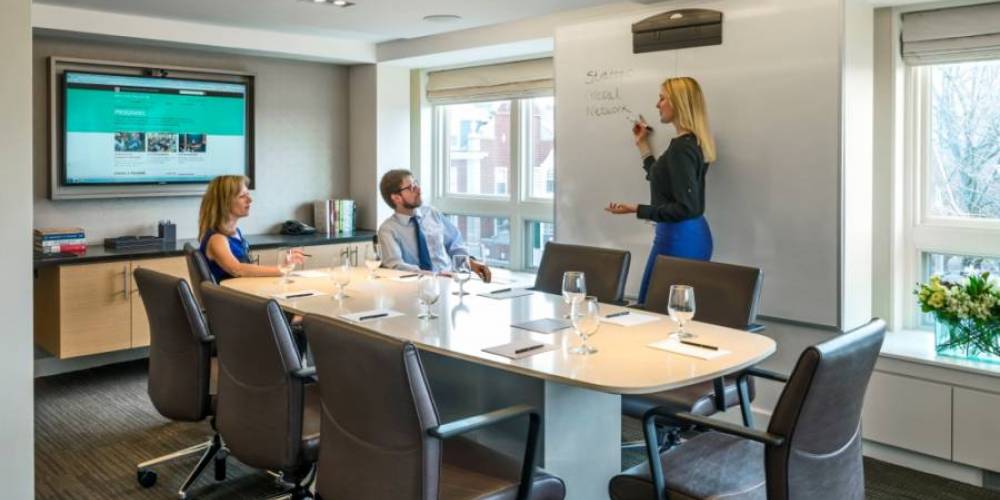
Three of the most influential technology trends are the reduction in on-site technology equipment space requirements, the increasing mobility of devices, users and applications, and the growing use of collaboration tools and activities.
How do design approaches often conflict with technology trends?
- Current design approaches to technology are commonly retrospective. For example, how many project design meetings have you attended where you heard, “In our past projects…”, “Other clients have said…”, or, “We have not done that in other projects.”? Another common owner-side phrase is, “Here are our standards and what we expect.” From a future-sensitive perspective these approaches look back in history and away from the impact of trending technologies. This increases the distance between what is typically designed and where the technologies and uses will be when the project is completed. Effective technology design requires that all parties are looking toward the future and identifying specific actual requirements for the project at hand.
- Mobility – In our recent survey of college students, no respondent had ever used a patch cord to plug their laptop or tablet into a wired data jack. At the same time, almost every one of the institutions that they attend have standards and practices that demand that multiple outlet cable jacks be installed throughout new and renovated projects whether residential or academic. There is a serious gap between what is required and what is provided.
- Collaboration – The use of devices to access information that is on-line, “in the cloud”, and simultaneously available, allows people to interactively create, review, edit, and modify content. This is collaboration. But, how often do you attend design sessions where people stress that collaboration spaces require a large monitor with a group of people sitting in a horse shoe shape around it? This style of room design is configured for people to watch one-person work, not for a group to collaborate. The effective modern collaboration methods that we observe in education and business settings consist of multiple people each using their own device to access a common resource and simultaneously review, edit, and modify it. Modern collaboration is less dependent upon specific rooms or settings, it is based on the process of contributors leveraging their device of choice and accessing common resources to add value. Modern collaboration is effective regardless of geography. The common factor is access to shared resources, with good audio and visual communications.
How may we better integrate these trends into successful future-sensitive designs?
Reduction in on-site space requirements – A new university science research and academic building design included 1,000 square foot for “IT Server/Security Room.” When pressed about the requirements for these spaces, the university stated that they had two on-campus new data centers with high levels of availability and redundancy and didn’t know where this requirement originated. The designer said, “I heard that some grants may require servers to be secure, so you would need this room in the building, and you might need a security room.” The raw construction budget for this space was significant. Of greater concern is that the cost if this space had been fit-up with the power, cooling, cabinets, and consoles would have been over a million dollars. Result: The space was repurposed into a “commons” for education and group activities, meeting a specific program requirement that was not in the current design and budget. Conclusion: identify project specific requirements, rationalize them with future trends and current resources, and carry only validated needs into the design.
Mobility – A university academic science center started the design process with the direction that “Our students are wireless.” They ended the design process with “Our standards require four cables at each faceplate and we require multiple faceplates per room, space, corridor, etc.” This (vendor driven change) resulted in a total cost of over $1.8M for cabling and network electronics that the students will not use. High performance wireless connectivity was already included in the technology designs. In this case, the money did little to advance the project goals of creating spaces for effective learning. Conclusion: Sometimes it doesn’t make sense.
True collaboration – A large research facility designed a new space where everyone has a laptop. The design includes 38 “collaboration” and “small group workrooms.” Each of these spaces is equipped with a large wall mounted display and chairs packed around a table. In meetings, people all open their laptop and work on them throughout the session (not always on topic). The facility has concerns about security and is going to great lengths to mitigate display visibility to people walking in the adjacent corridors. Options include window films, automated window treatments, angling the monitor etc. Conclusion: Traditional (old) concepts of how people collaborate in the modern cloud-based world do not reflect emerging collaboration models. Focus on fewer dedicated spaces, recognize that collaboration is more about connectivity than geography, provide comfortable headsets, and support easy teamwork tools such as Skype, Hangouts, Webex, etc.
Published in High Profile's October 2018 issue.
